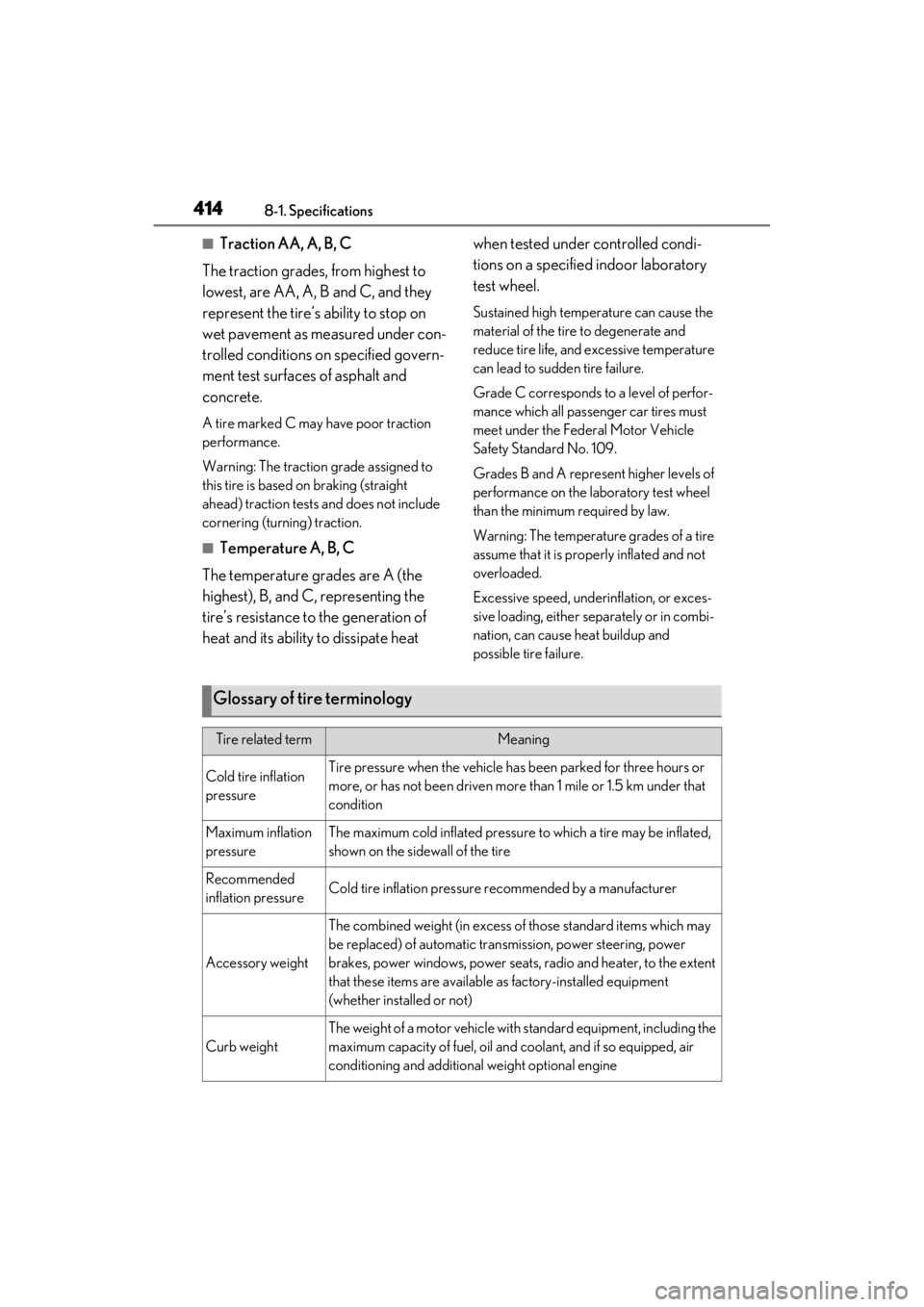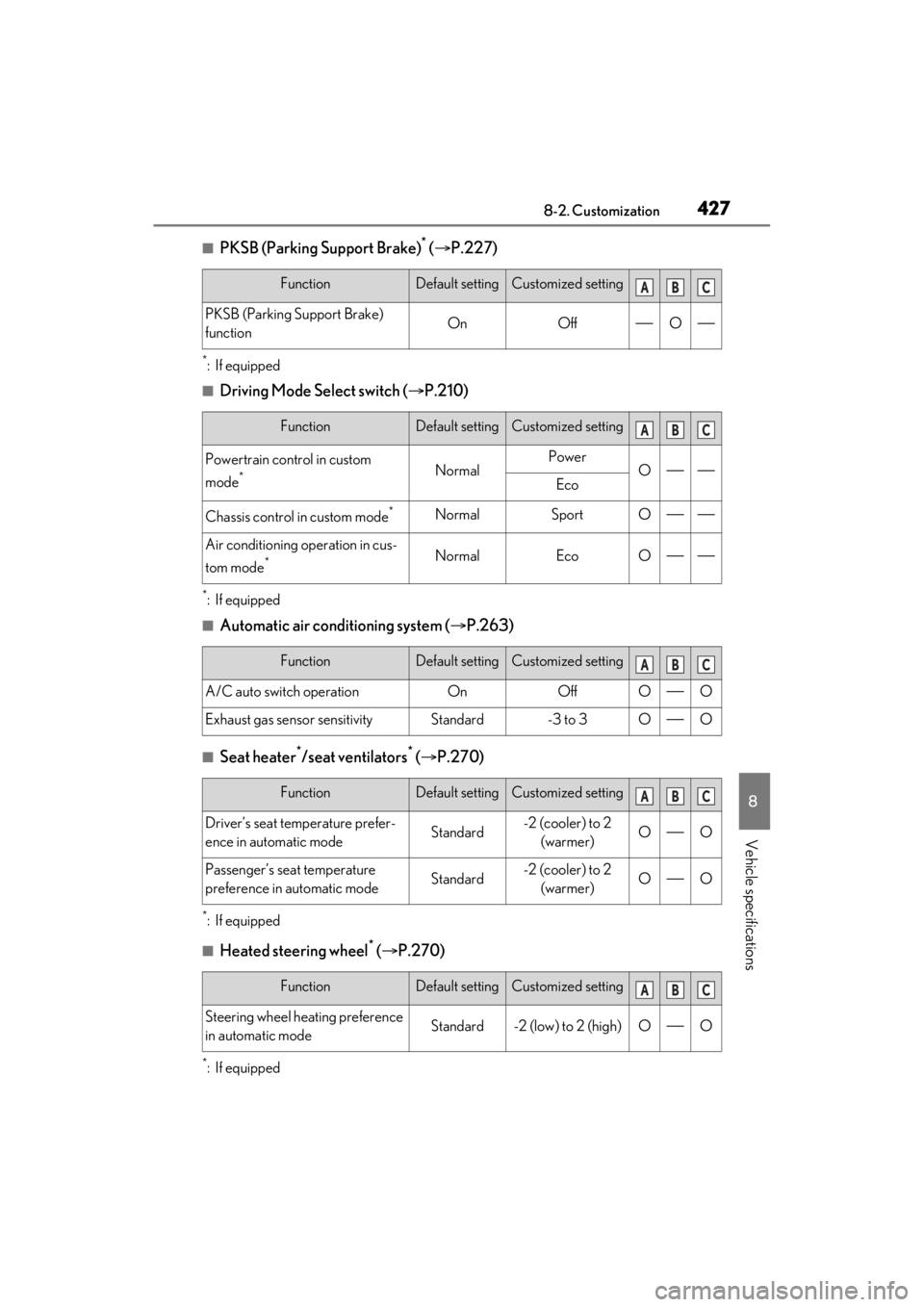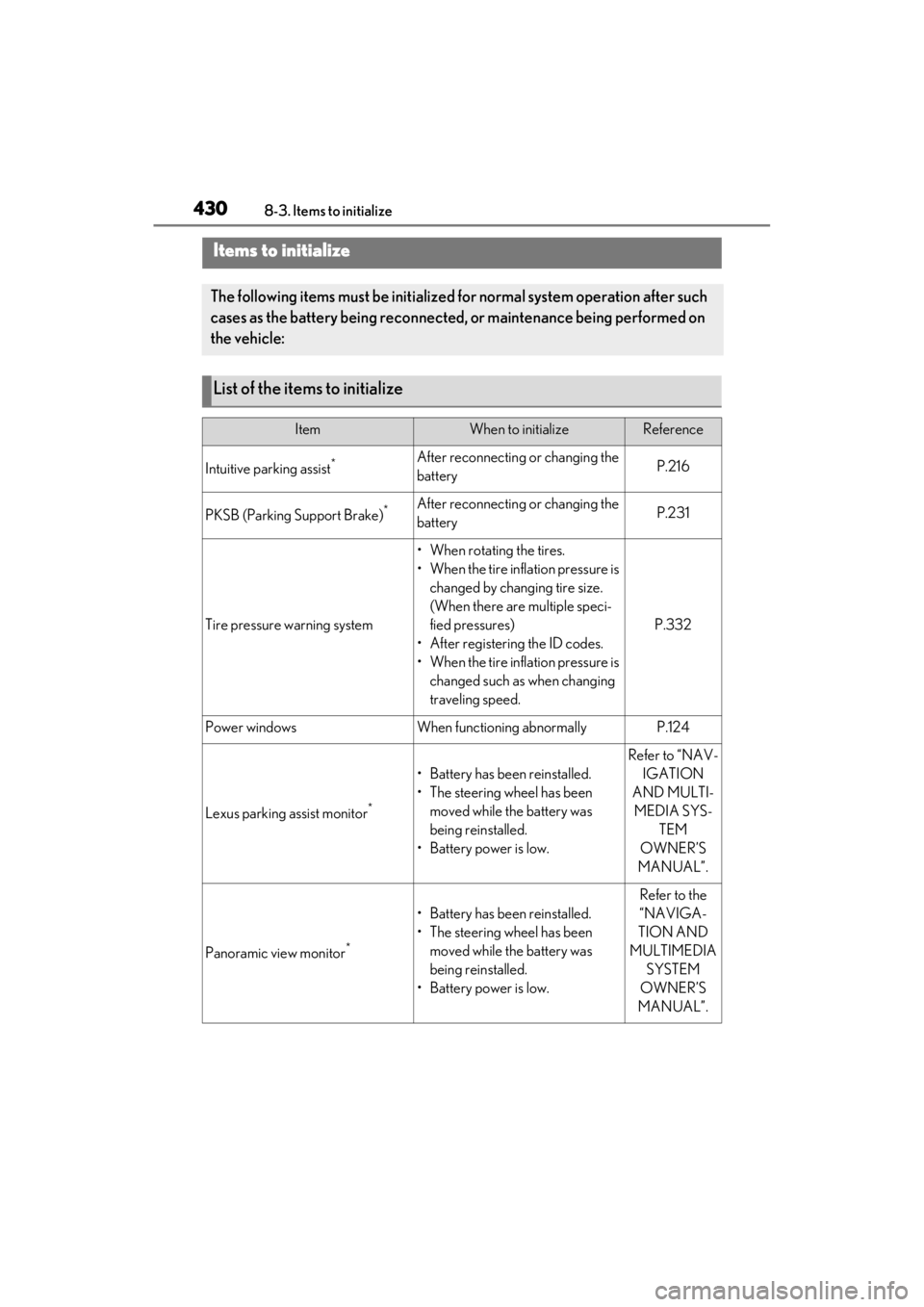Page 405 of 464
4058-1. Specifications
8
Vehicle specifications
*2: Make sure to confirm that the brake system warning light (yellow) does not illuminate. (If
the brake system warning light illuminates, refer to P.365.)
Type A
*1: 99 mph (160 km/h) or less
*2: More than 99 mph (160 km/h)
Steering
Free playLess than 1.2 in. (30 mm)
Tires and wheels
Tire size215/55R17 94V, T155/70D17 110M
Tire inflation pressure
(Recommended cold tire inflation pressure)
Front
36 psi (250 kPa, 2.5 kgf/cm
2 or bar)*1
46 psi (320 kPa, 3.2 kgf/cm2 or bar)*2
Rear
36 psi (250 kPa, 2.5 kgf/cm
2 or bar)*1
46 psi (320 kPa, 3.2 kgf/cm2 or bar)*2
Spare
60 psi (420 kPa, 4.2 kgf/cm
2 or bar)
Wheel size17 x 7 1/2J, 17 x 4T (compact spare)
Wheel nut torque76 ft•lbf (103 N•m, 10.5 kgf•m)
Page 414 of 464

4148-1. Specifications
■Traction AA, A, B, C
The traction grades, from highest to
lowest, are AA, A, B and C, and they
represent the tire’s ability to stop on
wet pavement as measured under con-
trolled conditions on specified govern-
ment test surfaces of asphalt and
concrete.
A tire marked C may have poor traction
performance.
Warning: The traction grade assigned to
this tire is based on braking (straight
ahead) traction tests and does not include
cornering (turning) traction.
■Temperature A, B, C
The temperature grades are A (the
highest), B, and C, representing the
tire’s resistance to the generation of
heat and its ability to dissipate heat when tested under controlled condi-
tions on a specified indoor laboratory
test wheel.
Sustained high temperature can cause the
material of the tire to degenerate and
reduce tire life, and excessive temperature
can lead to sudd
en tire failure.
Grade C corresponds to a level of perfor-
mance which all passenger car tires must
meet under the Fede ral Motor Vehicle
Safety Standard No. 109.
Grades B and A represent higher levels of
performance on the laboratory test wheel
than the minimum required by law.
Warning: The temperature grades of a tire
assume that it is properly inflated and not
overloaded.
Excessive speed, unde rinflation, or exces-
sive loading, either separately or in combi-
nation, can cause heat buildup and
possible tire failure.
Glossary of tire terminology
Tire related termMeaning
Cold tire inflation
pressureTire pressure when the vehicle has been parked for three hours or
more, or has not been driven more than 1 mile or 1.5 km under that
condition
Maximum inflation
pressureThe maximum cold inflated pressure to which a tire may be inflated,
shown on the sidewall of the tire
Recommended
inflation pressureCold tire inflation pressure recommended by a manufacturer
Accessory weight
The combined weight (in excess of those standard items which may
be replaced) of automatic tran smission, power steering, power
brakes, power windows, power seats, radio and heater, to the extent
that these items are available as factory-installed equipment
(whether installed or not)
Curb weight
The weight of a motor vehicle with standard equipment, including the
maximum capacity of fuel, oil and coolant, and if so equipped, air
conditioning and additional weight optional engine
Page 423 of 464
4238-2. Customization
8
Vehicle specifications
■Trunk (P.99)
*:If equipped
■Driving position memory* ( P.114)
*:If equipped
■Outside rear view mirrors ( P.121)
Trunk unlocking operationPress and hold
(short)
One short press
O
Push twice
Press and hold (long)
Off
Theft deterrent panic modeOnOffO
Reservation lockOnOffOO
FunctionDefault settingCustomized setting
Hands Free Power Trunk Lid (kick
sensor)
*OnOffO
FunctionDefault settingCustomized setting
Selecting doors linked to the mem-
ory recall functionDriver’s doorAll doorsO
Driver’s seat slide movement when
exiting the vehicle
*FullOffOOPartial
Steering wheel movement*Tilt only
Off
OOTelescopic only
Tilt and telescopic
FunctionDefault settingCustomized set- ting
Automatic mirror folding and
extending operation
*
Linked to the lock-ing/ unlocking of the doorsOff
OLinked to opera-
tion of the engine switch
FunctionDefault settingCustomized settingABC
ABC
ABC
ABC
Page 425 of 464

4258-2. Customization
8
Vehicle specifications
■LTA (Lane Tracing Assist) (P.184)
■RSA (Road Sign Assist)* ( P.193)
*:If equipped
■BSM (Blind Spot Monitor)* ( P.205)
Adjust alert timingMiddleEarlyOLate
FunctionDefault settingCustomized setting
Lane centering functionOnOffO
Steering assist functionOnOffO
Alert typeSteering wheel
vibrationBuzzerO
Alert sensitivityHighStandardO
Vehicle sway warning functionOnOffO
Vehicle sway warning sensitivityStandardHighOLow
FunctionDefault settingCustomized setting
RSA (Road Sign Assist)OnOffO
Excess speed noti fication methodDisplay onlyNo notificationODisplay and buzzer
Excess speed notification level1 mph (2 km/h)3 mph (5 km/h)O5 mph (10 km/h)
Other notifications method (No-
entry notification)Display onlyNo notificationODisplay and buzzer
FunctionDefault settingCustomized setting
BSM (Blind Spot Monitor)OnOffO
Outside rear view mirror indicator
brightnessBrightDimO
FunctionDefault settingCustomized settingABC
ABC
ABC
ABC
Page 427 of 464

4278-2. Customization
8
Vehicle specifications
■PKSB (Parking Support Brake)* ( P.227)
*:If equipped
■Driving Mode Select switch ( P.210)
*:If equipped
■Automatic air conditioning system ( P.263)
■Seat heater*/seat ventilators* ( P.270)
*:If equipped
■Heated steering wheel* ( P.270)
*:If equipped
FunctionDefault settingCustomized setting
PKSB (Parking Support Brake)
functionOnOffO
FunctionDefault settingCustomized setting
Powertrain control in custom
mode
*NormalPowerOEco
Chassis control in custom mode*NormalSportO
Air conditioning operation in cus-
tom mode
*NormalEcoO
FunctionDefault settingCustomized setting
A/C auto switch operationOnOffOO
Exhaust gas sensor sensitivityStandard-3 to 3OO
FunctionDefault settingCustomized setting
Driver’s seat temperature prefer-
ence in automatic modeStandard-2 (cooler) to 2
(warmer)OO
Passenger’s seat temperature
preference in automatic modeStandard-2 (cooler) to 2 (warmer)OO
FunctionDefault settingCustomized setting
Steering wheel heating preference
in automatic modeStandard-2 (low) to 2 (high)OO
ABC
ABC
ABC
ABC
ABC
Page 430 of 464

4308-3. Items to initialize
8-3.Items to initialize
Items to initialize
The following items must be initialized for normal system operation after such
cases as the battery being reconnected, or maintenance being performed on
the vehicle:
List of the items to initialize
ItemWhen to initializeReference
Intuitive parking assist*After reconnecting or changing the
batteryP.216
PKSB (Parking Support Brake)*After reconnecting or changing the
batteryP.231
Tire pressure warning system
• When rotating the tires.
• When the tire inflation pressure is changed by changing tire size.
(When there are multiple speci-
fied pressures)
• After registering the ID codes.
• When the tire inflation pressure is changed such as when changing
traveling speed.
P.332
Power windowsWhen functioning abnormallyP.124
Lexus parking assist monitor*
•Battery has be en reinstalled.
• The steering wheel has been moved while the battery was
being reinstalled.
• Battery power is low.
Refer to “NAV- IGATION
AND MULTI- MEDIA SYS- TEM
OWNER’S
MANUAL”.
Panoramic view monitor*
•Battery has be en reinstalled.
• The steering wheel has been moved while the battery was
being reinstalled.
• Battery power is low.
Refer to the
“NAVIGA-
TION AND
MULTIMEDIA SYSTEM
OWNER’S
MANUAL”.
Page 446 of 464

446What to do if... (Troubleshooting)
1-1.What to do if... (Troubleshooting)What to do if... (Troubleshooting)
If you lose your mechanical keys,
new genuine mechanical keys can
be made by your Lexus dealer.
( P.386)
If you lose your electronic keys, the
risk of vehicle theft increases signifi-
cantly. Contact your Lexus dealer
immediately. ( P.386)
Is the electronic key battery weak or
depleted? ( P.341)
Is the engine switch in IGNITION
ON mode?
When locking the doors, turn the engine
switch off. ( P.147)
Is the electronic key left inside the
vehicle?
When locking the doors, make sure that
you have the electronic key on your per-
son.
The function may not operate prop-
erly due to the condition of the radio
wave. ( P.108)
Is the child-protector lock set?
The rear door cannot be opened
from inside the vehicle when the
lock is set.
Open the rear door from outside
and then unlock the child-protector
lock. ( P.98)
The function to prevent the elec-
tronic key from being left inside the
trunk will operate and you can open
the trunk as usual. Take the key out
from the trunk. ( P.103)
Did you press the engine switch
while firmly depressing the brake
pedal? ( P.144)
Is the shift lever in P? ( P.149)
Is the electronic key anywhere
detectable inside the vehicle?
( P.106)
Is the steering wheel unlocked?
( P.145)
Is the electronic key battery weak or
depleted?
If you have a problem, check the
following before contacting your
Lexus dealer.
The doors cannot be locked,
unlocked, opened or closed
You lose your keys
The doors cannot be locked or
unlocked
The rear door cannot be opened
The trunk lid is closed with the
electronic key left inside
If you think something is wrong
The engine does not start
Page 447 of 464

447What to do if... (Troubleshooting)
In this case, the engine can be started in a
temporary way. ( P.388)
Is the battery discharged?
( P.389)
Is the engine switch in IGNITION
ON mode?
If you cannot release the shift lever
by depressing the brake pedal with
the engine switch in IGNITION ON
mode ( P.150)
It is locked automatically to prevent
theft of the vehicle. ( P.145)
Is the window lock switch pressed?
The power window at the except for the
one at the driver’s seat cannot be operated
if the window lock switch is pressed.
( P.125)
The auto power off function will be
operated if the vehicle is left in
ACCESSORY or IGNITION ON
mode (the engine is not running) for
a period of time. ( P.147)
The seat belt reminder light is flash-
ing
Are the driver and the passengers wearing
the seat belts? ( P.364)
The parking brake indicator is on
Is the parking brake released? ( P.154)
Depending on the situation, other
types of warning buzzer may also
sound. ( P.361, 371)
Did anyone inside the vehicle open
a door during setting the alarm?
The sensor detects it and the alarm sounds.
( P.63)
To stop the alarm, turn the engine
switch to IGNITION ON mode, or
start the engine.
Is the message displayed on the
multi-information display?
Check the message on the multi-informa-
tion display. ( P.371)
When a warning light turns on or a
warning message is displayed, refer
to P.361, 371.
The shift lever cannot be shifted
from P even if you depress the
brake pedal
The steering wheel cannot be
turned after the engine is
stopped
The windows do not open or
close by operating the power
window switches
The engine switch is turned off
automatically
A warning buzzer sounds during
driving
An alarm is activated and the
horn sounds
A warning buzzer sounds when
leaving the vehicle
A warning light turns on or a
warning message is displayed